Data is starting to show the impact of the Supreme Court’s decision to strike down affirmative action.
As the first class since the Supreme Court’s decision to strike down affirmative action entered college this year, the potential impacts of that decision are also emerging. After it was revealed enrollment of students of color dipped at some of the nation’s leading higher learning institutions, it appears fewer students are disclosing their race on applications.
According to new data by the think tank and nonprofit education advocacy organization Education Reform Now (ERN), not only did students who identify as Black or African American “significantly decline,” but so did the number of students disclosing their race during the application phase.
ERN, which has been tracking enrollment at “highly selective” colleges and universities for the past month, analyzed data from 34 institutions to arrive at its findings.
While these early findings do not bode well, the organization cautions against jumping to conclusions. However, they do agree that some of the recent changes in college enrollment appear to be related to the Supreme Court decision.
“It is far too soon to attribute causes to enrollment outcomes this year,” researchers said in their report.
They continued, “We barely know what happened with freshman enrollment post-SFFA; we certainly do not know why it happened. It is clear that the SFFA decision, which barred the consideration of race in college admissions decisions, had an impact on enrollment, but it is too soon to know precisely what that impact was, how widespread it was, how it interacted with other factors, and whether this year’s enrollment effects will persist over time.”
Recommended Stories
- As a new school year starts, Black student enrollment is down at multiple elite colleges
- Howard University named #1 among HBCUs on Forbes America’s Top Colleges List
- What are the most regrettable college majors?
- Harvard reports slight decline in Black students in wake of affirmative action ruling
- Botched college financial aid form snarls enrollment plans for students
Researchers also discovered that colleges and universities have varied methods for tracking race among their student bodies, making collecting and analyzing data even more challenging.
Another researcher tracking college admissions told USA Today that he often feels like he’s comparing “apples to pears.”
As previously reported by theGrio, other factors beyond the Supreme Court’s decision could be contributing to the changes in college enrollment. Some of these factors could be systemic, including financial. College, a historically expensive endeavor, has only gotten more expensive over time with inflation.
Despite it being an early phase in research (the first class has been in school for only two months), ERN and others have begun tracking admissions, in large part because of the ongoing curiosity about how college admissions are changing. They also want to be ready as the story continues to develop with time. For now, it’s clear the tide is changing. Exactly how and why things are changing could become clearer in time.
!function(){var g=window;g.googletag=g.googletag||{},g.googletag.cmd=g.googletag.cmd||[],g.googletag.cmd.push(function(){g.googletag.pubads().setTargeting(“has-featured-video”,”true”)})}(); ( () => { ( ( cb ) => { window.tpd = window.tpd || {}; if ( true === tpd.cmpReady ) { console.log( ‘[TPD][Brid] CMP was already ready, running player.’ ); cb(); return; } let tpdCmpReadyListener = () => { console.log( ‘[TPD][Brid] CMP ready event fired, running player.’ ); window.removeEventListener( ‘tpd:cmpCb’, tpdCmpReadyListener ); cb(); }; window.addEventListener( ‘tpd:cmpCb’, tpdCmpReadyListener ); } )( () => { let s = document.createElement( ‘script’ ); s.src = ‘https://player.target-video.com/player/build/targetvideo.min.js’; s.async = true; let target = document.getElementById( ‘Brid_21951’ ); target.parentElement.insertBefore( s, target ); window._bp = window._bp || []; window._bp.push( {“div”:”Brid_21951″,”obj”:{“id”:”41122″,”width”:”1280″,”height”:”720″,”stickyDirection”:”below”,”playlist”:”21951″,”slide_inposition”:”.widget_tpd_ad_widget_sticky”}} ); } ); } )();






